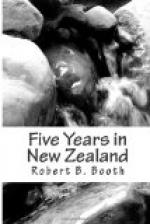The faculty of buckjumping is, I believe, almost confined to Australian horses, and seems to be bred in them—perhaps the original rough breaking was responsible for the vice; but whatever be the cause it was then a fact that eight out of every ten horses could and did buckjump, and with many of them the vice was incurable. An experienced buckjumper will decide as the saddle is being put on him to get rid of it as soon as possible without any apparent reason for such reprehensible conduct. He will swell himself out so that the girths cannot be fully tightened, and when he is mounted will suddenly bound off the ground, throw down his head, and prop violently on his fore feet, and this he will continue to repeat till the saddle comes on to his withers, and the rider finds some other resting place. So long as the saddle keeps its position, and the girths hold, there is a chance for the rider, but if they go he must, although he frequently goes without them.
There is a special saddle made for buckjumpers, provided with heavy pads to prop the knee against, and so prevent the rider from being chucked forward, and this is sometimes assisted by securely fastening an iron bar with a roll of blanket around it across the pommel of the saddle. This presses across the thighs just above the knees, and affords great additional security, and a surcingle is strapped over the seat of the saddle as a further assistance to the girths.
There is also another plan adopted with a really bad brute—namely, a crutch of wood or iron fastened to a martingale below, with two rings above, through which the reins are led. This contrivance is to prevent the animal lowering his head, which is a necessary movement on his part for accomplished bucking.
CHAPTER X.
I UNDERTAKE EMPLOYMENT
WITH A BUSH CONTRACTOR—GET SERIOUSLY
ILL—START
FOR THE SOUTH AND THE GOLD DIGGINGS.
I had now been more than a month on the Ashburton, but as I could not expect home letters yet for some weeks, and was getting tired of mere amusement, I accepted an offer made me to join in a new line of work.
A man named Metcalfe, a relative of a neighbouring squatter, had lately started work as a bush contractor, and had just then undertaken to construct a number of station buildings for a run holder on the Ashburton. Metcalfe was an experienced bushman and a good rough carpenter. He asked me to join him and I at once accepted.
We would have to fell and cut up our own timber in the forest, cart it down some forty miles, and construct all the works without other assistance.




